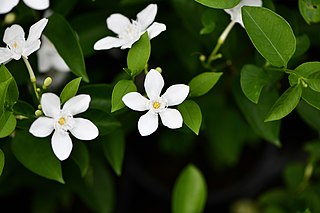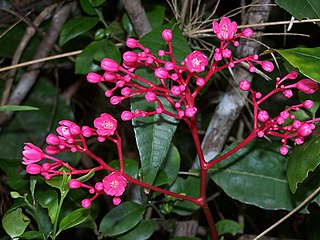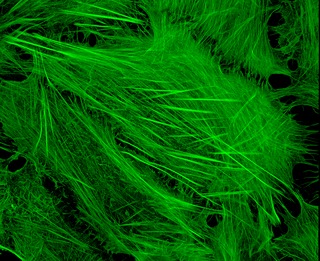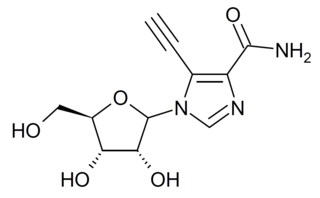
Idarubicin or 4-demethoxydaunorubicin is an anthracycline antileukemic drug. It inserts itself into DNA and prevents DNA unwinding by interfering with the enzyme topoisomerase II. It is an analog of daunorubicin, but the absence of a methoxy group increases its fat solubility and cellular uptake. Similar to other anthracyclines, it also induces histone eviction from chromatin.

Brucea is a genus of plant in the family Simaroubaceae. It is named for the Scottish scholar and explorer James Bruce.

Enediynes are organic compounds containing two triple bonds and one double bond.

Arsthinol (INN) is an antiprotozoal agent. It was synthesized for the first time in 1949 by Ernst A.H. Friedheim by complexation of acetarsol with 2,3-dimercaptopropanol and has been demonstrated to be effective against amoebiasis and yaws. It was marketed few years later by Endo Products . Among trivalent organoarsenicals, arthinol was considered as very well tolerated. Recently, it was studied for its anticancer activity.

Romidepsin, also known as Istodax, is an anticancer agent used in cutaneous T-cell lymphoma (CTCL) and other peripheral T-cell lymphomas (PTCLs). Romidepsin is a natural product obtained from the bacterium Chromobacterium violaceum, and works by blocking enzymes known as histone deacetylases, thus inducing apoptosis. It is sometimes referred to as depsipeptide, after the class of molecules to which it belongs. Romidepsin is branded and owned by Gloucester Pharmaceuticals, now a part of Celgene.

Wrightia antidysenterica, the coral swirl or tellicherry bark, is a flowering plant in the genus Wrightia. Wrightia antidysenterica is sometimes confused with the species Holarrhena pubescens due to a second, taxonomically invalid publication of the name Holarrhena pubescens. It has long been known in Indian Ayurvedic tradition. It is known in Sanskrit as kuṭaja or ambikā and in Sinhala it is called වල් ඉද්ද. It is also known as "white angel" in the Philippines and in Thailand it is called "พุดพิชญา" (pudpitchaya).

Simarouba is a genus of trees and shrubs in the family Simaroubaceae, native to the neotropics. It has been grouped in the subtribe Simaroubina along with the Simaba and Quassia genera. They have compound leaves, with between 1 and 12 pairs of alternate pinnate leaflets. Their flowers are unisexual, relatively small and arranged in large panicles. The individual flowers have between 4 and 6 sepals and petals and between 8 and 12 stamens. The fruit is a carpophore and has up to 5 drupaceous mericarps.

Flavaglines are a family of natural products that are found in plants of the genus Aglaia (Meliaceae). These compounds are characterized by a cyclopenta[b]benzofuran skeleton. In 1982 King and colleagues discovered the first member of this family, rocaglamide, based on its antileukemic activity. Since then, about 50 other flavaglines have been characterized. These molecules display strong insecticidal, antifungal, anti-inflammatory, neuroprotective, cardioprotective and anticancer activities. In mouse models of cancer, flavaglines enhance the efficacy of chemotherapies and also alleviate the cardiac adverse effect of these chemotherapies.

Cytoskeletal drugs are small molecules that interact with actin or tubulin. These drugs can act on the cytoskeletal components within a cell in three main ways. Some cytoskeletal drugs stabilize a component of the cytoskeleton, such as taxol which stabilizes microtubules or Phalloidin which stabilizes actin filaments. Others such as Cytochalasin D bind to actin monomers and prevent them from polymerizing into filaments. Drugs such as demecolcine act by enhancing the depolymerisation of already formed filaments. Some of these drugs have multiple effects on the cytoskeleton, for example Latrunculin both prevents actin polymerization as well as enhancing its rate of depolymerization. Typically the microtubule targeting drugs can be found in the clinic where they are used therapeutically in the treatment of some forms of cancer. As a result of the lack of specificity for specific type of actin the use of these drugs in animals results in unacceptable off target effects. Despite this the actin targeting compounds are still useful tools that can be used on a cellular level to help further our understanding of how this complex part of the cells internal machinery operates. For example, Phalloidin which has been conjugated with a fluorescent probe can be used for visualizing the filamentous actin in fixed samples.

Bruceanols are quassinoids isolated from Brucea antidysenterica.

Quassinoids are degraded triterpene lactones of the Simaroubaceae plant family grouped into C-18, C-19, C-20, C-22 and C-25 types. The prototypical member of the group, quassin, was first described in the 19th century from plants of the genus Quassia from which it gets its name. It was isolated in 1937 and its structure elucidated in 1961.

Brucea javanica is a shrub in the family Simaroubaceae. The specific epithet javanica is from the Latin, meaning "of Java". Other common names in English include Java brucea and kosam.

EICAR is a drug which acts as an inhibitor of the enzyme IMP dehydrogenase. It is a nucleoside derivative which has both anti-cancer and antiviral effects, and was originally developed for the treatment of leukemia, but was unsuccessful in human clinical trials. It has broad spectrum antiviral effects with activity against pox viruses, Semliki forest virus, Junin virus, reovirus, influenza, measles virus and respiratory syncytial virus among others, although it is not active against coronaviridae such as SARS-CoV-1. This useful spectrum of activity means that EICAR and related derivatives continue to be investigated for the treatment of viral diseases.

Bruceanol A is a cytotoxic quassinoid isolated from Brucea antidysenterica with potential antitumor and antileukemic properties.

Bruceanol C is a cytotoxic quassinoid isolated from Brucea antidysenterica with potential antitumor and antileukemic properties.

Bruceanol D is a cytotoxic quassinoid isolated from Brucea antidysenterica with potential antitumor and antileukemic properties.

Bruceanol E is a cytotoxic quassinoid isolated from Brucea antidysenterica with potential antitumor and antileukemic properties.

Bruceanol F is a cytotoxic quassinoid isolated from Brucea antidysenterica with potential antitumor and antileukemic properties.

Bruceanol G is a cytotoxic quassinoid isolated from Brucea antidysenterica with potential antitumor and antileukemic properties.

Bruceanol H is a cytotoxic quassinoid isolated from Brucea antidysenterica with potential antitumor and antileukemic properties.




















